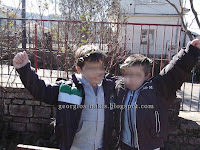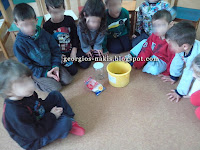 |
| Παιδιά μαζεύουν ελιές |
Following are photos with the development steps of the topic.
During the olive harvest, around the end of November, a child whose parents are olive growers brought to school some olive branches with their fruit (the branches came from pruning and not from reckless cutting), as well as olive harvesting tools. The children explored the branches and tools, while a relevant discussion followed (sharing experiences, expressing assumptions, concerns, etc).
Start
During the olive harvest, around the end of November, a child whose parents are olive growers brought to school some olive branches with their fruit (the branches came from pruning and not from reckless cutting), as well as olive harvesting tools. The children explored the branches and tools, while a relevant discussion followed (sharing experiences, expressing assumptions, concerns, etc).
Visit to an olive grove
The children, through an experiential experience, came in contact with the environment of the olive grove, saw and participated in the process of harvesting olives, ate their food under an olive tree and sat on the olive harvest cloth as a picnic, got a few olives in their food taper after the encouragement of the owner of the olive grove, got acquainted with various agricultural machines and tools with the help of an employee in the olive grove, saw hens grazing freely on the estate, they painted ...
In the olive mill
It was a visit with the kindergarten children to an olive mill in the area where they live, where they saw up close how the oil is produced, but also other aspects of the mill, such as its waste, as well as various parts of its equipment. A typical image was the mechanical weighing scale, where the children were weighed first separately and then all together, comparing their weight depending on the position of the sliding index.
Children's "running race" with an olive wreath prize
(the symbolic value of the olive tree in Ancient Greece)
Preparation of olives for food
Having a few olive branches, which came from pruning and were offered by the owner of the olive grove during the visit of the kindergarten there, the following steps were taken to prepare olives for food: the olive fruit was removed from the branches, washed, carved with a knife, left in the water to clear, then salt, oil and vinegar were added to prepare it for eating.
Making an olive branch (leaf collage)
Using basically olive leaves, the children reconstructed the olive branch shape on a piece of paper.
A few words about the interdisciplinary and holistic development of the project
The above activities are indicative of an experiential and interdisciplinary approach. The topic "olive and olive oil" is offered for a number of separate educational activities and can be expanded accordingly (eg different uses of olive oil, nutrition, etc.) approaching different areas of knowledge, such as biology, physics, mathematics, etc.
Besides, this happened anyway during the development of the above activities, since e.g. the children thought mathematically (measuring olives and leaves, sorting by color, comparing their weight on the mechanical weighing scale of the mill, perceiving the distance during the "running race" etc), learnt new words related to the subject (language), refered to the symbolism of olive trees in Ancient Greece (history), knew some chemical properties of materials (solubility of salt in water during the preparation of olives for food), observed with a magnifying glass the characteristics of the olive fruit, etc.
Respectively, after the children's experiential experiences, some activities continued in the classroom, such as worksheets, visual arts (eg, creating an olive grove model), reading relevant fairy tales and reciting poems, songs with lyrics about olive and olive oil, etc.



















































